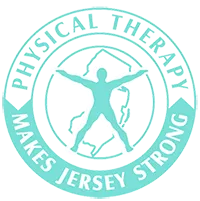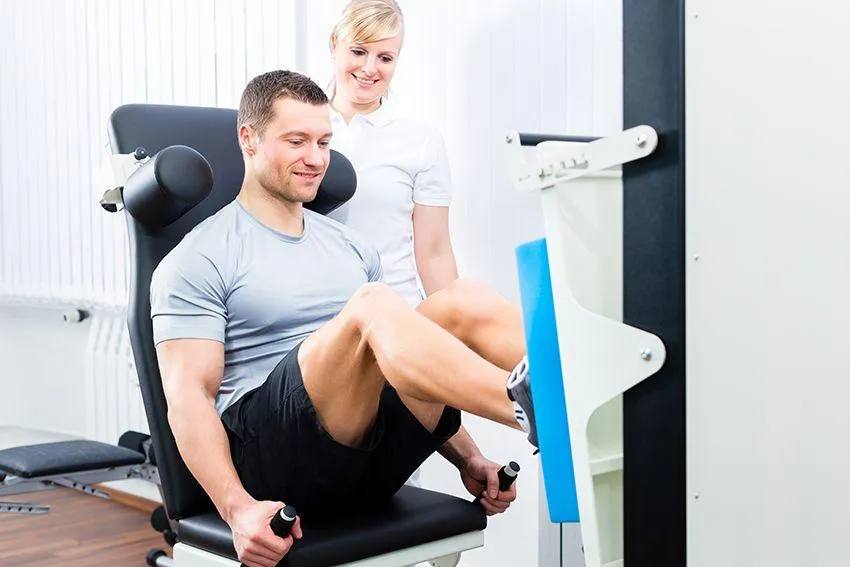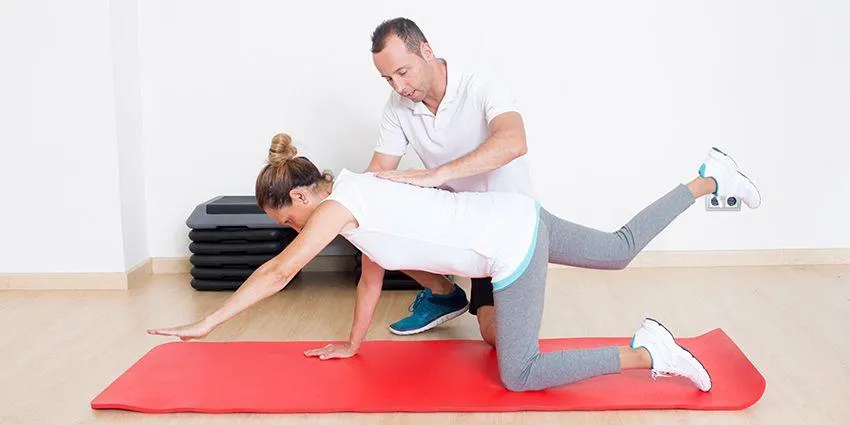New Jersey Rehab Experts
Specializing in comprehensive orthopedic care, New Jersey Rehab Experts offers a wide range of services including Physical Therapy, Sports Physical Therapy, Dry Needling, Chiropractic Care, Neuropathy Treatment, Pain Management, and Manual Therapy. Our state-of-the-art facility is staffed by board-certified therapists dedicated to delivering top-tier care, ensuring you achieve optimal recovery and wellness.
Clinic Located in Jersey City (Newport), Secaucus and Clifton
Genuine Feedback from
Our Patients
Our Affiliations






Explore Our Diverse Range of Disciplines
Discover a world of exceptional care customized for all ages! Our dedicated professionals deliver top-notch medical attention, expert rehabilitative therapy, and warm companion care for adults, seniors, and young patients. Experience personalized healthcare with a heart!

Orthopedic Physical Therapy
Specialized care for musculoskeletal injuries, surgeries, and chronic conditions affecting bones, joints, muscles, ligaments, and tendons.
- Sports injuries
- Arthritis management
- Post-surgical rehab

Geriatric Physical Therapy
Specialized care for older adults, addressing age-related changes affecting balance, strength, mobility, and independence.
- Fall prevention
- Balance training
- Mobility enhancement

Sports Physical Therapy
Specialized rehab for athletes of all levels, from weekend warriors to professionals, focusing on injury recovery and performance enhancement.
- ACL rehab
- Return-to-play testing
- Performance optimization

Vestibular Rehabilitation
Specialized therapy for dizziness, vertigo, and balance disorders stemming from inner ear and balance system dysfunction.
- BPPV treatment
- Balance retraining
- Dizziness management

Men's Health Physical Therapy
Specialized care for pelvic floor dysfunction and related issues, providing discreet, effective treatment for men's specific health needs.
- Pelvic pain relief
- Post-prostatectomy rehab
- Urinary dysfunction

Motor Vehicle & Work Injury Rehab
Specialized care for car accidents and workplace injuries, with expert documentation and coordination with insurance providers.
- Whiplash treatment
- Workers' comp cases
- Personal injury claims

Manual Therapy
Hands-on approach using specialized techniques to relieve pain, improve mobility, and accelerate healing naturally.
- Mulligan Mobilizations
- McKenzie Method
- Myofascial Release

Dry Needling
Modern technique using thin, sterile needles to target trigger points, releasing muscle tension and restoring normal function.
- Back & neck pain
- Headaches & migraines
- Sports injuries
Ready to start your recovery journey?
Our expert therapists are ready to help you live pain-free and regain your mobility.
Our Advantages
Specialized Programs for Every Need
From orthopedic rehab and sports therapy to vestibular, pelvic health, and post-injury recovery, we provide comprehensive, patient-focused solutions.
State-of-the-Art Techniques & Technology
We use cutting-edge treatments like dry needling, spinal manipulation, Mulligan & McKenzie techniques, Fit3D scans, Shockwave Therapy , Cupping and more to accelerate healing.
Personalized One-on-One Care
Every patient receives individualized treatment plans with hands-on attention to ensure faster recovery and long-term results.
Trusted by Athletes & Community Leaders
Official providers for multiple cricket teams and a member of respected healthcare associations—our reputation speaks for itself.
Multiple Convenient Locations Across NJ
With clinics in Jersey City, Secaucus, Clifton , and beyond, we’re always within reach—offering flexible scheduling and bilingual support.
Seamless Support for Injury Claims & Recovery
We coordinate care with attorneys, physicians, and insurers for patients recovering from motor vehicle or work-related injuries, ensuring smooth documentation and stress-free rehab.
Meet Our Team

Sunny Thakkar PT, MS ( Exercise Physiologist)
Physical Therapist

Ashish Sinha, PT, DPT
Physical Therapist

Dr. Rohit Farzala PT, DPT
Physical Therapist
About Us


Experience rapid rejuvenation as our specialist team harnesses the power of advanced healing tech to erase pain with ease. We dive deep into your world, assessing every piece of the puzzle—stress at work, life pressures, physical health, nutrition, genes, posture, and even emotional ties—crafting a tailor-made wellness blueprint that's as unique as you are. With our dedicated holistic touch, we don't just treat symptoms; we empower you to embrace a pain-free, harmonious life.
Ask a Question

Text Neck: Understanding the Digital Age Epidemic and How to Find Relief
Text Neck: Understanding the Digital Age Epidemic and How to Find Relief
In today's digital landscape, where screens dominate our daily lives, many of us are unknowingly falling victim to a modern affliction known as "text neck." This posture-related condition arises from the excessive time spent looking down at smartphones and computers, resulting in a host of uncomfortable symptoms. As we hunched over our devices, the human spine, once designed for upright ease, is forced into unnatural angles that trigger pain and strain.
Understanding text neck is crucial not just for those already feeling its effects, but for anyone who wants to maintain a healthy relationship with technology. If you're experiencing stiffness, headaches, or discomfort in your neck and shoulders, you're not alone—and relief is within reach. In this article, we’ll explore the causes of this growing epidemic and reveal effective strategies to alleviate discomfort, restoring both your posture and peace of mind. Join us as we navigate the path toward a healthier, screen-friendly lifestyle!
The Rise of Text Neck in the Digital Age
In an era where digital devices have become an indispensable part of our lives, the phenomenon of "text neck" has emerged as a prevalent health concern. This condition, which results from the prolonged forward head posture associated with extensive use of smartphones, tablets, and computers, is increasingly common across all age groups. The modern dependence on digital technology for communication, work, and entertainment has inadvertently led to a surge in cases of text neck, making it a widespread issue in today's society.
Historically, humans did not spend as much time in a head-down posture as they do now. The evolution of technology has significantly altered our daily routines and physical habits. From the moment we wake up to the time we go to bed, many of us are constantly checking our devices, often without realizing the toll it takes on our bodies. This habitual behavior forces the neck into a forward-leaning position, which, over time, can lead to serious musculoskeletal problems.
The ubiquity of screens in our daily lives means that text neck is not just a problem for tech enthusiasts or office workers, but for everyone. Children and teenagers, who are spending increasing amounts of time on digital devices for both educational and recreational purposes, are particularly at risk. The long-term implications of text neck among younger populations are concerning, as early onset of poor posture can lead to chronic issues later in life. As such, understanding and addressing text neck is crucial for maintaining overall health and well-being in the digital age.
Symptoms and Signs of Text Neck
Text neck manifests through a variety of symptoms, many of which can be easily overlooked or attributed to other causes. One of the most common signs is neck pain, which can range from a dull ache to sharp, intense discomfort. This pain is often localized in the cervical spine and may radiate to the shoulders and upper back. Individuals with text neck might also experience stiffness and reduced range of motion in their neck, making it difficult to turn their head from side to side.
Headaches are another frequent symptom associated with text neck. The strain on the neck muscles can lead to tension headaches, which often start at the base of the skull and can spread to the forehead and temples. These headaches can be particularly debilitating, impacting one's ability to concentrate and perform daily activities. In severe cases, text neck can also cause neurological symptoms such as tingling, numbness, or weakness in the arms and hands, due to nerve compression.
In addition to physical discomfort, text neck can also affect posture and overall appearance. Individuals with text neck often develop a forward head posture, where the head juts out in front of the shoulders. This misalignment can lead to a hunched back and rounded shoulders, which not only looks unappealing but also places additional strain on the spine and muscles. Recognizing these symptoms early and taking proactive measures to address them is essential for preventing long-term damage and maintaining a healthy posture.
The Impact of Text Neck on Health
The health implications of text neck extend beyond mere discomfort and can significantly affect one's quality of life. Prolonged forward head posture places excessive stress on the cervical spine, which can lead to degenerative changes over time. The intervertebral discs, which act as cushions between the vertebrae, can become compressed, increasing the risk of herniated discs. This condition can cause severe pain and may require medical intervention, such as physical therapy or even surgery.
Chronic neck pain and stiffness can also interfere with daily activities and overall productivity. Simple tasks like driving, working on a computer, or even sleeping can become challenging and uncomfortable. Persistent pain can lead to a decrease in physical activity, as individuals may avoid exercise or other movements that exacerbate their symptoms. This sedentary lifestyle can contribute to other health issues, such as obesity, cardiovascular disease, and decreased mental well-being.
Moreover, the psychological impact of text neck should not be underestimated. Constant pain and discomfort can lead to increased stress, anxiety, and depression. The inability to engage in activities that were once enjoyable or necessary can result in feelings of frustration and helplessness. Addressing text neck is therefore not just about alleviating physical symptoms but also about improving overall mental and emotional health. By recognizing the far-reaching effects of this condition, individuals can take a comprehensive approach to their well-being and make necessary lifestyle changes.
Prevention Strategies for Text Neck
Preventing text neck involves adopting healthier habits and making conscious efforts to improve posture. One of the most effective strategies is to limit screen time and take regular breaks from digital devices. The 20-20-20 rule is a helpful guideline: every 20 minutes, take a 20-second break and look at something 20 feet away. This simple practice can reduce eye strain and encourage individuals to change their posture frequently, thereby reducing the risk of text neck.
Maintaining proper posture while using digital devices is crucial. When using a smartphone or tablet, hold the device at eye level to avoid looking down for extended periods. If possible, use a stand or holder to keep the device at the appropriate height. For computer use, ensure that the monitor is positioned at eye level and that the keyboard and mouse are within comfortable reach. Using an ergonomic chair that supports the natural curve of the spine can also make a significant difference.
Incorporating regular physical activity into your routine can help prevent text neck by strengthening the muscles that support the spine and improving overall flexibility. Activities such as yoga, Pilates, and swimming are particularly beneficial for promoting good posture and relieving tension in the neck and shoulders. Additionally, being mindful of your posture throughout the day, whether sitting, standing, or walking, can help prevent the development of text neck and other musculoskeletal issues.
Exercises and Stretches for Relief
Incorporating specific exercises and stretches into your daily routine can provide significant relief from text neck symptoms and help restore proper alignment. One effective exercise is the chin tuck, which strengthens the muscles at the front of the neck and helps correct forward head posture. To perform a chin tuck, sit or stand with your back straight, gently pull your chin back as if trying to make a double chin, and hold the position for a few seconds. Repeat this exercise several times throughout the day.
Another beneficial stretch is the neck extension stretch. To do this, sit or stand with your back straight, gently tilt your head backward, and look up towards the ceiling. Hold this position for 15-30 seconds, then return to the starting position. This stretch helps counteract the forward head posture and relieves tension in the neck muscles. Incorporating shoulder rolls into your routine can also help alleviate tightness in the shoulders and upper back. Simply roll your shoulders forward and backward in a circular motion several times.
Foam rolling can also be an effective way to relieve muscle tension and improve flexibility. Using a foam roller on the upper back and shoulders can help release tight muscles and improve mobility. Lie on your back with the foam roller positioned under your upper back, and gently roll back and forth, focusing on areas of tension. Additionally, incorporating exercises that strengthen the core and upper back muscles, such as planks and rows, can help support proper posture and reduce the strain on the neck.
Ergonomic Solutions for Reducing Text Neck
Creating an ergonomic workspace is essential for reducing the risk of text neck and promoting overall spinal health. Start by ensuring that your computer monitor is at eye level, so you don't have to look down or tilt your head forward. The top of the screen should be at or slightly below eye level, and the monitor should be about an arm's length away from your face. Using a monitor stand or adjustable desk can help achieve the correct height.
Your chair also plays a crucial role in maintaining good posture. Choose an ergonomic chair that supports the natural curve of your spine and allows you to sit with your feet flat on the floor. The chair should have adjustable height and lumbar support to keep your lower back properly aligned. If your chair does not provide adequate lumbar support, consider using a cushion or lumbar roll to maintain the natural curve of your lower back.
Positioning your keyboard and mouse correctly can also help prevent text neck. Ensure that your keyboard is at a height where your elbows are at a 90-degree angle and your wrists are straight while typing. The mouse should be within easy reach, and you should avoid stretching or leaning forward to use it. Using an ergonomic keyboard and mouse can also reduce strain on your wrists and shoulders, further promoting a comfortable and healthy workspace.
The Role of Technology in Managing Text Neck
While technology is often the cause of text neck, it can also be part of the solution. There are several apps and devices designed to help monitor and improve posture. Posture-correcting apps use the camera on your smartphone or computer to track your posture and provide real-time feedback. These apps can alert you when you start to slouch or hold your head in a forward position, encouraging you to make necessary adjustments.
Wearable devices, such as posture-correcting braces and sensors, can also be effective tools in managing text neck. These devices are designed to be worn on the upper back or neck and provide gentle reminders to maintain proper posture. Some devices vibrate or send notifications to your smartphone when they detect poor posture, helping you develop better habits over time. Additionally, smart desks and chairs with built-in sensors can monitor your posture and suggest adjustments to improve ergonomics.
Virtual reality (VR) technology is another innovative solution for managing text neck. VR-based exercises and training programs can help users improve their posture and strengthen the muscles that support the spine. These programs often include guided exercises, stretches, and relaxation techniques that can be performed in a virtual environment, making them an engaging and effective way to address text neck. By leveraging technology in a positive way, individuals can take proactive steps to manage and prevent text neck.
When to Seek Professional Help
While self-care strategies and ergonomic adjustments can be effective in managing text neck, there are times when professional help is necessary. If you experience persistent or severe neck pain, numbness, tingling, or weakness in your arms or hands, it is important to seek medical attention. These symptoms may indicate a more serious underlying condition, such as a herniated disc or nerve compression, which requires professional assessment and treatment.
A healthcare professional, such as a physical therapist, chiropractor, or orthopedic specialist, can provide a comprehensive evaluation and develop a personalized treatment plan. Physical therapy is often recommended for text neck, as it can help improve posture, strengthen the muscles that support the spine, and alleviate pain through targeted exercises and manual therapy techniques. A physical therapist can also provide guidance on proper ergonomics and posture correction strategies.
In some cases, additional interventions, such as medication, injections, or surgery, may be necessary to address severe or persistent text neck symptoms. It is important to follow the recommendations of your healthcare provider and adhere to the prescribed treatment plan. Early intervention and appropriate care can prevent the progression of text neck and improve overall quality of life. By seeking professional help when needed, individuals can achieve long-term relief and maintain a healthy, pain-free lifestyle.
Conclusion: Embracing a Healthier Digital Lifestyle
Text neck is a growing epidemic in the digital age, but it is one that can be managed and prevented with the right knowledge and strategies. By understanding the causes and symptoms of text neck, individuals can take proactive steps to protect their spine and overall health. Incorporating regular breaks, practicing good posture, and engaging in targeted exercises and stretches are all essential components of preventing and alleviating text neck.
Creating an ergonomic workspace and leveraging technology to monitor and improve posture can also play a significant role in maintaining a healthy relationship with digital devices. While self-care measures are important, it is also crucial to seek professional help when necessary to address severe or persistent symptoms. By taking a comprehensive approach to managing text neck, individuals can achieve lasting relief and enjoy a healthier, more balanced digital lifestyle.
As we continue to navigate the digital landscape, it is essential to prioritize our physical well-being and make conscious efforts to maintain good posture. By embracing healthier habits and being mindful of our screen time, we can prevent the onset of text neck and other related conditions. Ultimately, a healthier digital lifestyle not only enhances our physical health but also improves our overall quality of life, allowing us to fully enjoy the benefits of technology without compromising our well-being.
No matter whether your condition was caused by a sport, work accident or otherwise,
we welcome the chance to serve you.
Opening Hours





